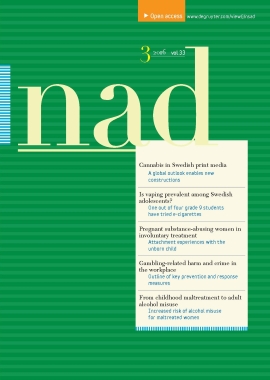NAD 3/2016 (June)

Continuity and change in Swedish print media constructions of cannabis
Josefin Månsson describes and analyses how cannabis is constructed in Swedish print media, and asks whether this has changed over time. The Swedish print media generally has a crime-centred and deterrent approach towards cannabis, with prohibition at the heart of the reporting. International events do however introduce discursive alternatives. It remains to be seen if these new ways of writing about cannabis will strengthen or challenge traditional Swedish prohibitionist constructions.
Pregnant substance-abusing women in involuntary treatment
Use of coercion against pregnant women who misuse substances was legalised in Norway in 1996. Siv Merete Myra and colleagues explored whether an attachment between the mother and her unborn child was possible in a context of coercion as experienced from the woman’s perspective. They found that involuntary detention enabled safety for and connection with the unborn child. Within this context, the pregnant substance-abusing women’s own relational experiences and developmental histories represent the most significant barrier for their ability to bond with the expected child.
Childhood maltreatment and alcohol misuse in a sample of Danish young adults
In their study, Susan Cronin, Siobhan Murphy and Ask Elklit examined the relationship between alcohol misuse and different types of childhood maltreatment in a sample of young adults. A significant relationship was found between childhood maltreatment and alcohol misuse. This relationship was significantly stronger for maltreated women, which identifies a gap in the literature. High associations between maltreatment and alcohol misuse in females may suggest alcohol is used as a coping strategy following childhood maltreatment.
Prevalence and risk factors of electronic cigarette use among adolescents
Is vaping prevalent among Swedish adolescents? Susanna Geidne and colleagues found that one out of four Swedish grade 9 students have tried e-cigarettes. They also found that the use of e-cigarettes tended to cluster with the use of other substances, such as other tobacco products and alcohol. The article is commented on by Karl E. Lund and Jaana M. Kinnunen.
Preventing and responding to gambling-related harm and crime in the workplace
Per Binde has studied gambling-related harm and crime in the workplace. In his outline of key prevention and response measures to problem gambling, he includes substance use and gambling policy, problem gambling awareness, attention to signs of gambling-related harm, control functions, appropriate responses to harmful gambling, and rehabilitation. According to Binde, the workplace should play a greater role in the universal, selective and indicated prevention of problem gambling
Follow us on social media:


